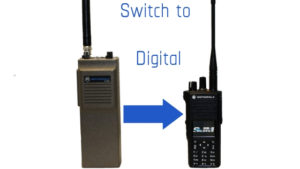Two-way digital radios help businesses work smarter … “copy that!”
News | 0 comments | by Vanessa Chavez

Successful businesses prioritize communication and two-way radios can take your business to the next level.
In virtually every industry, customers and clients expect to get what they want when they want it. If your business can’t deliver, they’ll look for another business that can. Being competitive in today’s business environment requires a solid communication strategy that provides instant response and immediate action.
read moreWhy Two-Way Radio is a Great Choice for Instant Communication
Digital Radios | 0 comments | by Vanessa Chavez

At some point in every WWII movie there is a dramatic scene where a soldier gets pinned down by gunfire, grabs his two-way radio and makes a plea for help. Although this may be a corny example, it does illustrate that two-way radio has been the first choice for instant communication by mission-critical organizations for quite some time.
Although military personnel have used radio communication ever since it was introduced back in the 1940’s, Community Emergency Operations and thousands of businesses soon followed. This made two-way radio the “go-to” choice for anyone seeking a robust communication system for over 60 years.
read moreIs It Time to Migrate to Digital? Part Four : Ease of Migration
Case Study | 0 comments | by Vanessa Chavez

Two considerations that organizations face when switching from analog to digital are: one, the potential loss of investment by decommissioning analog radios that still have a use-value; and two, the potential interruption to normal operations during the transition period.
To address these concerns, radio manufacturers engineered their new radios to provide both analog and digital voice communication in the same unit. This dual operation capability allows companies to keep their legacy analog radios in use along side of the new analog/digital radios. They can also continue to use their existing analog infrastructure with the new radios until the company is ready to switch over to a fully-digital system.
read moreIs It Time to Migrate to Digital? Part Three: Voice and Data
Case Study | 0 comments | by Vanessa Chavez
In Part Three of this series on Digital Migration, we cover Voice and Data.

Part Three: Voice and Data
Today’s digital two way radios have enhanced voice and data capabilities. This gives radio users the ability to run productivity-enhancing applications directly from their hand held radios.
Current applications include messaging, location based services, bar code reading, and form applications. And according to radio manufacturer information, the growth potential for new application development looks very promising as third-party developers report interest in developing more applications for the industry.
read moreIs It Time to Migrate to Digital? Part Two: Better Capacity
Case Study | 0 comments | by Vanessa Chavez
In Part Two of this series on Digital Migration, we discuss Better Capacity.

Part Two: Better Capacity
Regulatory pressures and real-world needs are driving a demand to expand the capacity of the business designated slice of the RF spectrum by leveraging new technology. As it happens, digital two way radio technology is very bandwidth efficient and actually allows two separate “channels” to operate on a single 12.5 kHz frequency. Effectively doubling its capacity. (See chart Above)
In addition to making efficient use of the RF spectrum, this feature helps minimize licensing costs associated with operational expansion because the additional channels do not require additional frequencies. For a fast growing business that is expanding its radio operations this can mean significant savings while expanding communications.
read more
